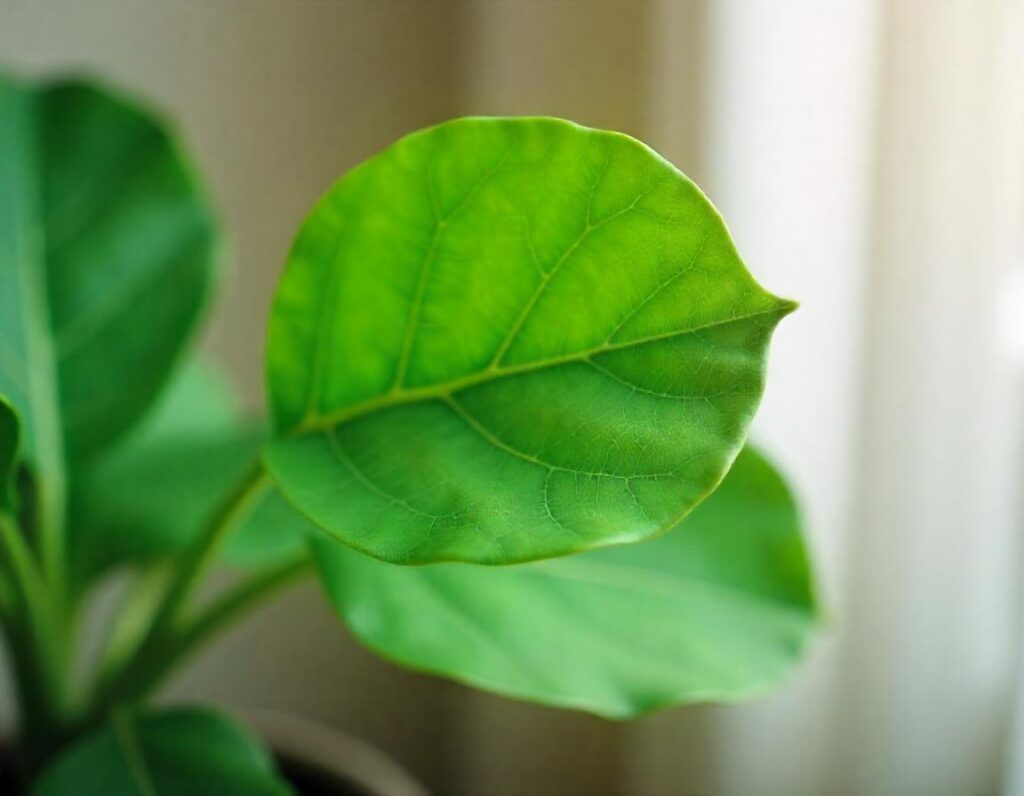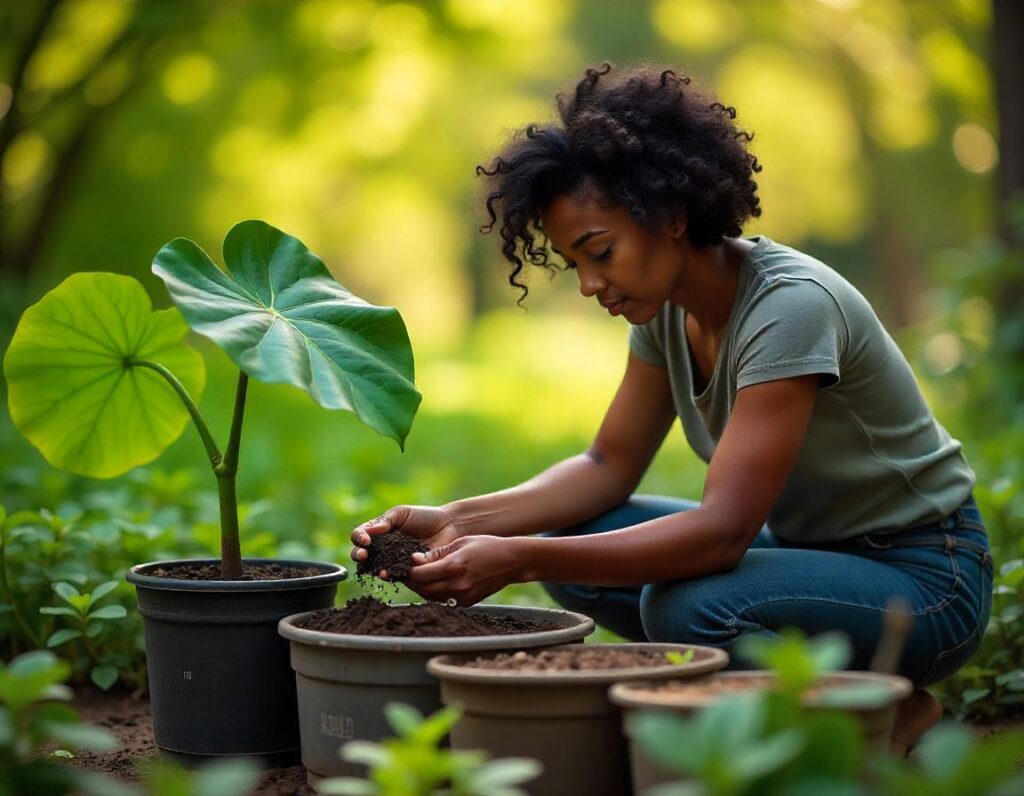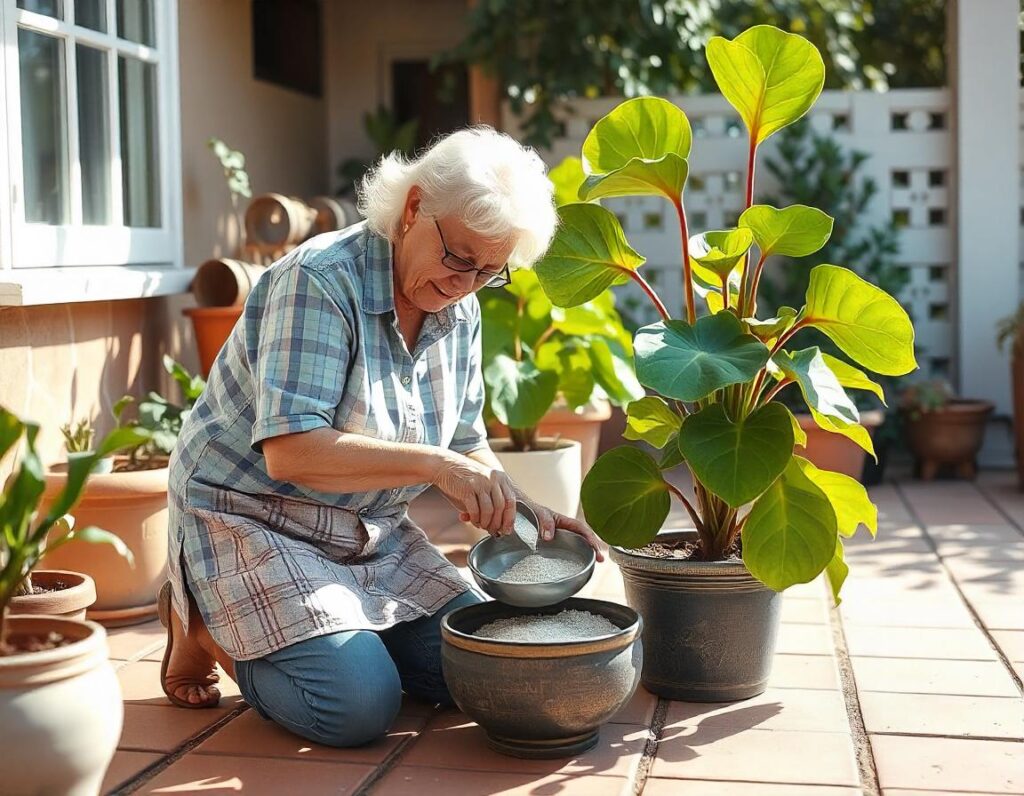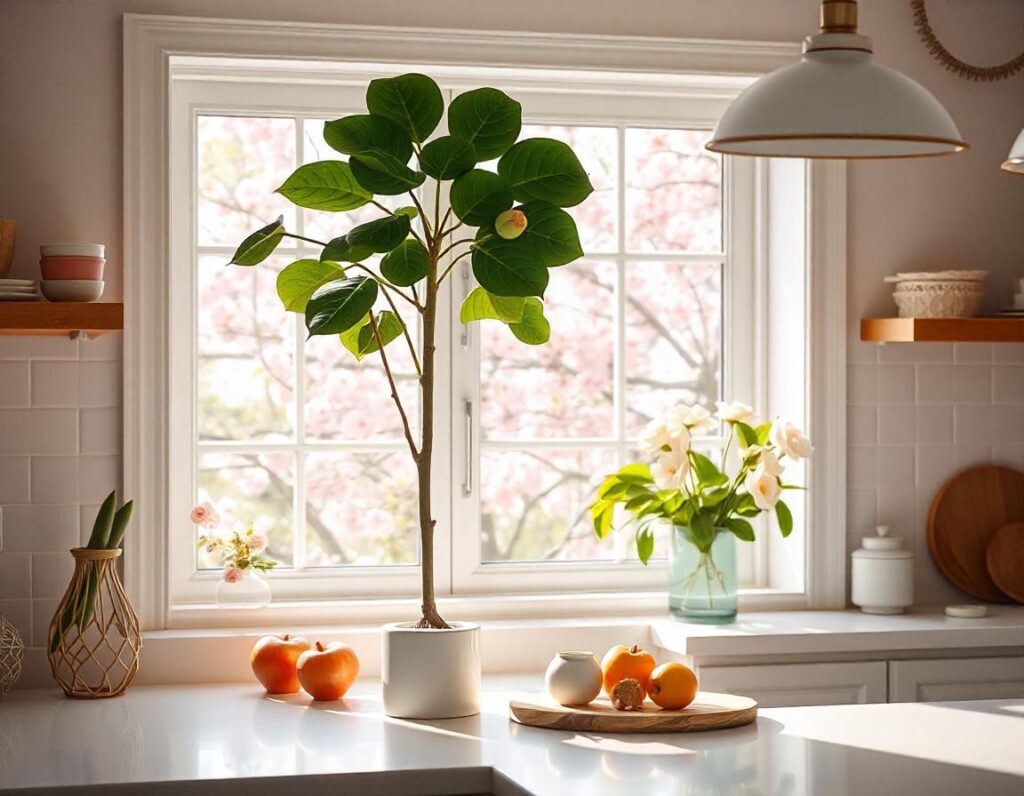The Fiddle Leaf Fig, a prominent feature in contemporary home decor, captivates plant enthusiasts with its broad, glossy leaves. As a beginner, understanding its specific care requirements is crucial for ensuring a healthy, vibrant plant that enhances your living space.
In this comprehensive Fiddle Leaf Fig care guide, we provide insights into optimizing watering, lighting, soil, and humidity conditions. Whether mastering repotting techniques or troubleshooting common issues, understanding these aspects will empower you to nurture your plant effectively and beautifully.
Introduction to the Fiddle Leaf Fig
The fiddle leaf fig, scientifically known as Ficus lyrata, has gained widespread popularity as an indoor plant in recent years. Originating from the tropical rainforests of West Africa, it is renowned for its strikingly large, violin-shaped leaves and its impressive vertical growth.

Appreciated for its aesthetic appeal, the fiddle leaf fig enhances interior spaces with its bold foliage. It requires specific care to thrive, making understanding its needs imperative for both novices and experienced plant enthusiasts. This plant serves as an excellent focal point in any room, balancing elegance with modern decor.
Known for its air-purifying qualities, the fiddle leaf fig contributes to improved air quality within enclosed spaces. Its towering presence provides a lush, vibrant atmosphere, thereby elevating both home and office environments. Proper care contributes to its longevity and beauty, ensuring it remains an integral part of one’s interior design.
Mastering Watering and Humidity
Understanding the watering needs of a Fiddle Leaf Fig is fundamental to its care. Proper assessment of moisture levels in your plant’s soil is vital. Check by inserting your finger about an inch into the soil. If dry, it is time to water.
Creating a humid environment is essential for the Fiddle Leaf Fig to thrive. This plant prefers humidity levels between 30% and 65%. Use a humidifier or place a pebble tray filled with water beneath the pot to boost humidity.

Avoid overwatering, as it can lead to root rot. Allow the soil to dry out between watering sessions. Proper drainage with a pot that has holes ensures that excess water drains away, preventing waterlogged roots, fostering a healthy plant environment.
Assessing Moisture Levels
For successful Fiddle Leaf Fig care, routinely assessing moisture levels is imperative. Insert your finger into the soil up to the first knuckle. If the soil feels dry, it’s time to water. This simple tactile method prevents over-watering, a common issue faced by beginners.
Employing a moisture meter is an effective alternative. These devices offer precise readings, indicating whether the soil is too dry or excessively moist. A moisture meter is particularly beneficial for those unfamiliar with the tactile approach, providing a reliable guide to moisture monitoring.
Observing the foliage can further aid in assessing moisture needs. Drooping leaves might indicate inadequate watering, while yellowing leaves can suggest over-watering. Such visual cues, combined with other assessment methods, ensure a holistic approach to moisture management for your Fiddle Leaf Fig.
Creating a Humid Environment
Fiddle Leaf Figs thrive in environments with humidity levels between 30% and 65%. To achieve the ideal humidity, consider using a humidifier. This device can maintain consistent moisture in the air, especially during dry seasons or in air-conditioned rooms.
Alternatively, regular misting can help boost humidity around your plant. Use a spray bottle filled with water to lightly mist the leaves, simulating a more humid environment. However, avoid over-wetting as it might invite leaf fungal issues.
Grouping plants together is another effective method. As plants transpire, they naturally increase the humidity around them. This collective moisture creates a microenvironment beneficial for your Fiddle Leaf Fig. Ensure enough space between plants for air circulation.
Lastly, consider placing a shallow tray filled with water and pebbles beneath the plant. When the water evaporates, it adds humidity to the immediate surroundings. Keep the pot elevated above the waterline to prevent root rot.
Optimal Lighting Setup
For an optimal lighting setup, place your Fiddle Leaf Fig in a location that receives abundant natural light. It requires bright, indirect sunlight to thrive. Direct sunlight can scorch the leaves, causing unsightly spots and discoloration on the foliage.
Situate the plant near east-facing windows, where it can receive consistent morning light without harsh afternoon rays. If direct sunlight is unavoidable, diffuse it with sheer curtains to protect the leaves. Adequate lighting will promote healthy growth and vibrant leaf color.

During the winter months, light levels may diminish. Consider supplementing with artificial grow lights to maintain sufficient exposure. Position the grow lights about 12 to 18 inches above the plant to mimic natural sunlight and enhance the Fiddle Leaf Fig’s development.
Crafting the Perfect Soil Environment
Selecting the appropriate soil blend is integral to successful Fiddle Leaf Fig care. A well-draining potting mix ensures the plant receives adequate moisture while preventing root rot. Look for soil mixes specifically designed for indoor tropical plants, which typically contain components like peat moss, pine bark, and perlite.

Incorporating perlite into the mix enhances drainage and aeration, crucial for healthy root development. This component helps maintain moisture levels optimal for Fiddle Leaf Fig growth, mitigating risks associated with waterlogging or drought conditions. Regularly assess and adjust soil composition to cater to your plant’s changing needs.
Consider adding organic matter like compost to enrich the soil with nutrients. Organic amendments improve fertility and microbial activity, fostering a supportive environment for the Fiddle Leaf Fig. Consistent monitoring and adjustment of the soil environment contribute to robust growth and overall vitality.
Fertilizing Your Fiddle Leaf Fig
Understanding the appropriate fertilization for your Fiddle Leaf Fig is integral to its robust growth. Using a balanced, water-soluble fertilizer with an N-P-K ratio of 3-1-2 is recommended. This formulation aligns with the plant’s nutrient needs, fostering both foliage and root development.
Apply fertilizer during the active growing months, typically from spring through early fall. This period aligns with the plant’s natural growth cycle, allowing it to effectively absorb nutrients. Reduce or cease fertilization during the dormant winter months when growth slows.

Ensure the fertilizer is diluted to half the recommended strength to avoid over-fertilizing, which can damage the roots. It’s important to water the plant before applying fertilizer, preventing nutrient burn by ensuring the roots are hydrated.
Regular feeding every month during the growing season supports consistent leaf production. Monitor your plant’s response; if leaves yellow or drop, it may indicate nutrient overabundance. Regular observation and adjustment will guide optimal Fiddle Leaf Fig care.
Repotting: Best Practices
Repotting a Fiddle Leaf Fig involves recognizing when this practice is necessary for plant health. Signs that repotting is needed include roots protruding from drainage holes or visible root binding on the soil’s surface. These indicators suggest the plant’s current container has become restricting.
Start the repotting process by selecting a new container that is one to two inches larger in diameter than the current pot. Ensure the container has ample drainage to prevent water accumulation, which can lead to root rot. Proper drainage is critical for healthy root development.

Gently remove the plant from its existing pot, taking care not to damage the root system. Loosen the roots if they appear tightly wound, allowing for better growth in their new environment. Place the Fiddle Leaf Fig at the same soil level in the new pot, ensuring it’s stable before adding new soil.
Fill the remaining space with a high-quality potting mix, pressing it gently to remove air pockets. After repotting, water the plant thoroughly to help settle the soil and eliminate any remaining air gaps. Observing the plant post-repotting ensures its adjustment and continued growth in its refreshed environment.
Recognizing Repotting Signs
Recognizing signs for repotting your Fiddle Leaf Fig is essential for maintaining its health and promoting growth. One notable indication is roots protruding from the drainage holes. This suggests that the plant is becoming root-bound and requires a larger pot to accommodate its expanding root system.
Another sign is the soil drying out rapidly after watering. This indicates that the plant has absorbed all the available nutrients, and the current potting medium is insufficient. A larger container with fresh soil will ensure the plant receives the necessary nourishment.
Additionally, if growth appears stunted despite optimal care, it may be time to consider repotting. A cramped root system restricts nutrient uptake, leading to slow foliage development. Lastly, yellowing leaves or a general decline in vigor could imply the need for fresh soil and increased space.
Steps in the Repotting Process
Begin by gently removing the Fiddle Leaf Fig from its current pot. Ensure minimal disturbance to the root ball. Inspect the roots for any rot or damage, trimming unhealthy areas with sterilized tools. This prepares the plant for a healthy transition.
Select a pot that is slightly larger than the current one, with sufficient drainage holes. Fill the base with a layer of fresh, well-draining soil, specifically formulated for tropical plants. This provides a firm foundation and good drainage for your Fiddle Leaf Fig.
Position the plant in the center of the new pot, ensuring it stands upright. Gradually fill in around the root ball with additional soil, pressing gently to remove any air pockets. Be cautious not to bury the stem too deeply.
After repotting, water the plant thoroughly to help it settle and remove any lingering air pockets. Maintain regular watering as the plant acclimates to its new pot, promoting healthy growth in its fresh soil environment.
Troubleshooting and Problem-Solving
Brown edges on the Fiddle Leaf Fig’s leaves can indicate inadequate watering or humidity. Check soil moisture regularly, ensuring it remains consistently damp without waterlogging. Low humidity levels, common in indoor environments, may also contribute to this problem.
Drooping leaves can be a sign of over-watering or under-watering distress. If the leaves appear wilted post-watering, subsequent watering should be more spaced apart. Conversely, if leaves remain limp and dry, the plant may require more consistent hydration.

To address ongoing issues, monitor any environmental changes impacting the Fiddle Leaf Fig’s health. Drafts and sudden temperature shifts often trigger stress responses that affect leaf appearance. Adjust the plant’s environment to ensure stability and mitigate adverse reactions.
Persistent issues may necessitate further investigation of pest infestations or root rot. Inspect roots for signs of decay and treat with fungicide, if necessary. Pests, such as mites or aphids, often require targeted insecticidal treatments to manage infestations effectively.
Brown Edges
Brown edges on your Fiddle Leaf Fig can be indicative of several care issues. Often, inconsistent watering leads to this problem. Fiddle Leaf Figs prefer evenly moist soil. Excessive dryness or water-logged conditions can cause edges to turn brown.
Poor humidity levels can also contribute to browning edges. Fiddle Leaf Figs thrive in humid environments. Low humidity may cause dehydration, resulting in brown leaf edges. Increasing room humidity or using a pebble tray can help mitigate this issue.
Nutritional imbalances might also lead to brown edges. Over-fertilization causes salt build-up, burning the leaf margins. It’s important to use a balanced, diluted fertilizer during active growth periods. Regularly flushing the soil can prevent excess salt accumulation.
Lastly, pest infestation, such as spider mites, can damage leaves. These pests feed on leaf cells, leading to brown, dry edges. Regularly inspect your Fiddle Leaf Fig and use appropriate treatments to control pest problems efficiently.
Drooping Leaves
Drooping leaves in Fiddle Leaf Figs often signal improper care, yet understanding the causes can aid in effective management. Over-watering is a common culprit, as it inhibits root oxygen absorption, leading to weak, sagging leaves. Ensure the soil drains adequately to prevent this issue.
Under-watering can also result in drooping, as the plant struggles to maintain its structure with limited hydration. Evaluate the soil moisture by inserting a finger about two inches deep; if it feels dry, the plant likely needs water. Maintaining consistent watering routines supports optimal plant health.
Insufficient light is another factor contributing to droopy leaves. Fiddle Leaf Figs require bright, indirect light for sustained vitality. Repositioning the plant closer to a light source can often revive drooping foliage. These adjustments in care can significantly enhance overall plant appearance.
Addressing container constraints is equally important. If the plant outgrows its pot, the roots may become constrained, restricting nutrient uptake and causing leaf droop. Timely repotting ensures enough space for root expansion, improving both nutrient uptake and plant stability.
Controlling Humidity for Growth Enhancement
Humidity significantly influences the health and growth of a Fiddle Leaf Fig. Maintaining an optimal humidity level can promote vibrant leaf development. Aim for a humidity level between 40% to 60% to ensure optimal growth conditions for your plant.
To increase humidity, consider utilizing a room humidifier, particularly in arid climates or during winter. The humidifier should be placed close to the Fiddle Leaf Fig to maintain consistent moisture levels around the plant’s leaves.
Another effective approach involves grouping plants together, as this naturally increases local humidity through transpiration. Alternatively, periodically misting the leaves with water can serve as a quick method to elevate humidity levels temporarily.
Monitoring the humidity using a hygrometer can provide valuable insights into the ambient climate surrounding your plant. Adjust your methods accordingly if the readings fluctuate beyond the ideal range for your Fiddle Leaf Fig.
Propagation Techniques Simplified
Propagation of the Fiddle Leaf Fig offers a rewarding method to grow new plants. The most successful technique involves stem cuttings. You should select a healthy branch with at least two to three leaves. This ensures optimal energy storage for successful growth.
Start by cutting below a node, a small bump along the stem where leaves emerge. Remove lower leaves, retaining only the topmost leaf or two. This minimizes energy use on maintaining leaves, allowing the cutting to focus on root development.

Place the cutting in a jar of water, ensuring the node is submerged. Position the jar in a spot with indirect sunlight. Maintain consistent water levels and monitor for root growth, typically seen in four to six weeks.
Once roots develop, transplant the cutting into well-draining soil. Ensure the pot offers adequate drainage and maintain a consistent watering routine. Monitor the young plant for new leaf growth, indicating successful propagation.
Effective Pruning and Shaping
Pruning a Fiddle Leaf Fig not only aids in maintaining its health but also enhances its visual appeal. Regular trimming involves removing dead or damaged leaves to promote robust growth. Cutting back leggy branches helps maintain a balanced and attractive shape.
When deciding the right time to prune, consider early spring as it encourages new growth during the active growing season. Using clean, sharp pruning shears minimizes stress to the plant. For shaping, remove leaves and branches thoughtfully to achieve the desired silhouette.
For aesthetic appeal, target branches growing inward or crossing others, as these may cause crowding. Allow light to penetrate through the canopy, improving overall growth conditions. Always step back and assess the plant’s form during the process.

Strategic pruning also effectively controls the size of your Fiddle Leaf Fig. If it has outgrown its space, top pruning reduces its height while encouraging branching. Remember to make cuts at a slight angle, just above a node, to foster healthy regrowth.
When to Prune
Pruning Fiddle Leaf Figs is best performed during the growing season, typically in spring through early summer. This timing allows the plant to recover rapidly. Avoid pruning in late fall or winter when the plant is generally dormant.
Evaluate the size and shape of your Fiddle Leaf Fig to decide if pruning is necessary. Prune when you notice overly long branches or when you want to encourage a denser growth pattern.
Consider pruning if your Fiddle Leaf Fig is struggling with lower sunlight. Pruning can help manage the plant’s energy and direct resources toward healthier leaves and branches. Additionally, prune off any damaged or yellowing leaves.
Ensure you have the correct tools, such as a pair of clean, sharp pruning shears. When pruning, make precise cuts above a node to encourage new growth. This process supports the overall health and shape of your Fiddle Leaf Fig.
Shaping for Aesthetic Appeal
Shaping your Fiddle Leaf Fig is an art that enhances its aesthetic appeal, allowing you to mold its appearance to fit your space. Begin by identifying the natural shape of your plant. This will guide you in achieving a balanced form.
Pruning is fundamental in shaping the fig. Remove leaves that disrupt the plant’s symmetry or aesthetics. Focus on cutting branches that cause overcrowding, ensuring your Fiddle Leaf Fig maintains its beauty and health. Use sterilized tools to avoid infections.
Consider the plant’s growth direction. Encourage growth by trimming parts that may hinder the spread of foliage. This meticulous shaping will allow you to achieve the desired height and fullness while promoting a visually pleasing structure.
Seasonal Care Guide
Understanding the seasonal needs of your Fiddle Leaf Fig can enhance its growth and resilience. During spring and summer, this plant enters an active growth phase. Ensure consistent watering, allowing the top inch of soil to dry between waterings.
In fall and winter, the Fiddle Leaf Fig’s growth slows. Reduce watering frequency to prevent overwatering and root rot. Maintain proper humidity levels, particularly in winter when indoor heating can dry out the air.

Consider light adjustments with changing seasons. As daylight decreases during fall and winter, position the plant to receive optimal direct light. This helps counteract reduced natural sunlight and keeps the plant vibrant.
Ensure a consistent temperature for your Fiddle Leaf Fig throughout the year. Avoid placing the plant near drafty windows or heating vents, which may cause temperature fluctuations detrimental to its health.
Preventing Pests and Diseases
Maintaining the health of your Fiddle Leaf Fig involves vigilance against pests and diseases. Common pests include spider mites, mealybugs, and scale insects. These pests can cause significant damage by sucking the sap from the leaves and stems, leading to poor growth.
Regularly inspect your plant for signs of infestation. Check the undersides of leaves and look for sticky residue or discolored spots. To prevent these pests, maintain optimal humidity levels and clean leaves with a damp cloth to remove dust and potential eggs.
Disease prevention requires attention to watering practices. Overwatering can lead to root rot, a common issue detrimentally affecting health. Use a well-draining soil mixture and ensure the plant’s pot has adequate drainage to minimize the risk of fungal infections.
Implement Integrated Pest Management (IPM) techniques for a holistic approach. This method includes natural insecticides, introducing beneficial insects like ladybugs, and employing cultural practices to create an environment inhospitable to pests. Through these strategies, you can effectively safeguard your Fiddle Leaf Fig against pests and diseases.
Safety Measures: Toxicity Awareness
Fiddle Leaf Figs are widely appreciated for their lush, vibrant foliage. However, they pose a risk due to their toxicity. They contain compounds that are harmful if ingested by humans and pets, potentially causing digestive distress and irritation.
To ensure safety, keep Fiddle Leaf Figs out of reach of children and pets. Educate household members about the plant’s potential hazards to prevent accidental ingestion or contact. Employ barriers or choose elevated placements to restrict access.
In the event of accidental ingestion, symptoms to monitor include oral irritation, drooling, and vomiting. Seek prompt medical advice if these symptoms occur. Awareness and proactive measures can help maintain a safe environment while enjoying the beauty of a Fiddle Leaf Fig.
Caring for a Fiddle Leaf Fig involves understanding its unique needs. From meticulous watering and humidity management to optimal lighting and soil conditions, each aspect is crucial in ensuring healthy growth and longevity.
Armed with this comprehensive care guide, you can confidently navigate challenges such as repotting, pruning, and disease prevention. Remember, a thoughtfully attended Fiddle Leaf Fig not only thrives but adds beauty and elegance to your living space.

